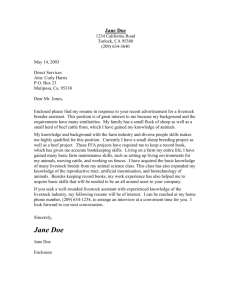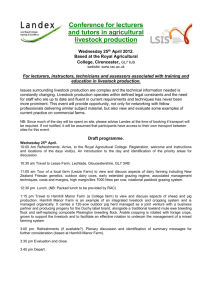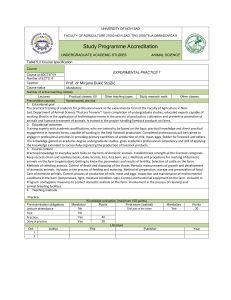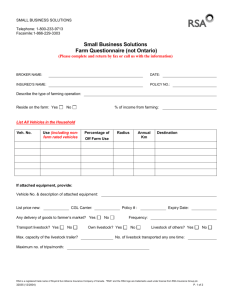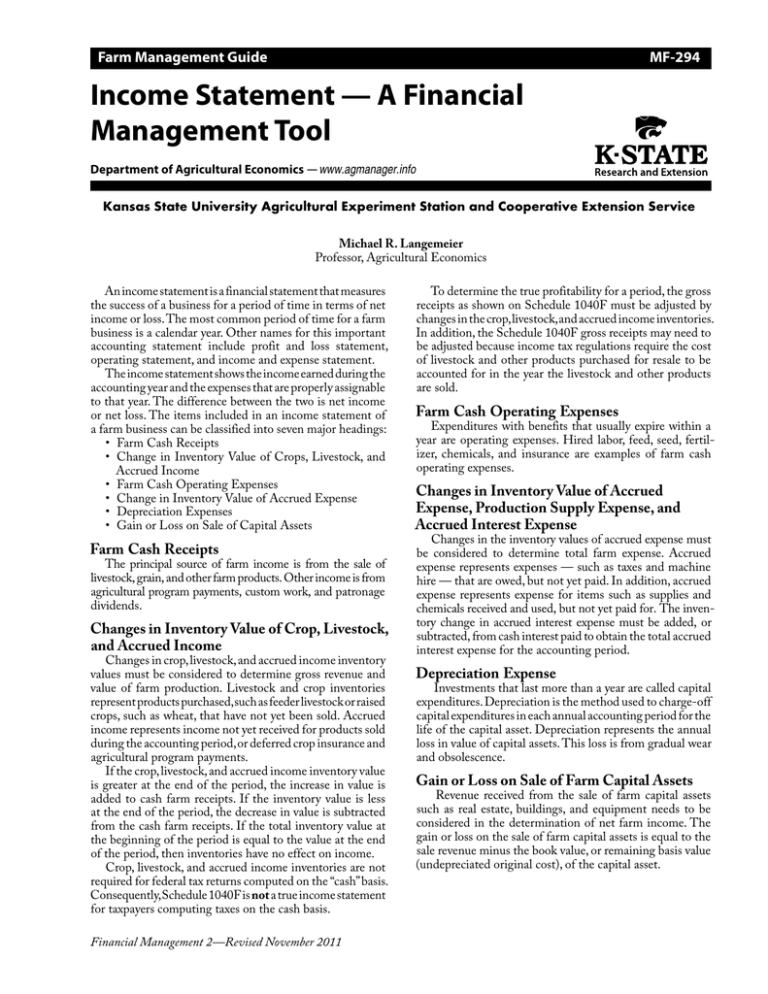
Farm Management Guide
MF-294
Income Statement — A Financial
Management Tool
Department of Agricultural Economics — www.agmanager.info
Kansas State University Agricultural Experiment Station and Cooperative Extension Service
Michael R. Langemeier
Professor, Agricultural Economics
To determine the true profitability for a period, the gross
receipts as shown on Schedule 1040F must be adjusted by
changes in the crop, livestock, and accrued income inventories.
In addition, the Schedule 1040F gross receipts may need to
be adjusted because income tax regulations require the cost
of livestock and other products purchased for resale to be
accounted for in the year the livestock and other products
are sold.
An income statement is a financial statement that measures
the success of a business for a period of time in terms of net
income or loss. The most common period of time for a farm
business is a calendar year. Other names for this important
accounting statement include profit and loss statement,
operating statement, and income and expense statement.
The income statement shows the income earned during the
accounting year and the expenses that are properly assignable
to that year. The difference between the two is net income
or net loss. The items included in an income statement of
a farm business can be classified into seven major headings:
• Farm Cash Receipts
• Change in Inventory Value of Crops, Livestock, and
Accrued Income
• Farm Cash Operating Expenses
• Change in Inventory Value of Accrued Expense
• Depreciation Expenses
• Gain or Loss on Sale of Capital Assets
Farm Cash Operating Expenses
Expenditures with benefits that usually expire within a
year are operating expenses. Hired labor, feed, seed, fertilizer, chemicals, and insurance are examples of farm cash
operating expenses.
Changes in Inventory Value of Accrued
Expense, Production Supply Expense, and
Accrued Interest Expense
Changes in the inventory values of accrued expense must
be considered to determine total farm expense. Accrued
expense represents expenses — such as taxes and machine
hire — that are owed, but not yet paid. In addition, accrued
expense represents expense for items such as supplies and
chemicals received and used, but not yet paid for. The inventory change in accrued interest expense must be added, or
subtracted, from cash interest paid to obtain the total accrued
interest expense for the accounting period.
Farm Cash Receipts
The principal source of farm income is from the sale of
livestock, grain, and other farm products. Other income is from
agricultural program payments, custom work, and patronage
dividends.
Changes in Inventory Value of Crop, Livestock,
and Accrued Income
Changes in crop, livestock, and accrued income inventory
values must be considered to determine gross revenue and
value of farm production. Livestock and crop inventories
represent products purchased, such as feeder livestock or raised
crops, such as wheat, that have not yet been sold. Accrued
income represents income not yet received for products sold
during the accounting period, or deferred crop insurance and
agricultural program payments.
If the crop, livestock, and accrued income inventory value
is greater at the end of the period, the increase in value is
added to cash farm receipts. If the inventory value is less
at the end of the period, the decrease in value is subtracted
from the cash farm receipts. If the total inventory value at
the beginning of the period is equal to the value at the end
of the period, then inventories have no effect on income.
Crop, livestock, and accrued income inventories are not
required for federal tax returns computed on the “cash” basis.
Consequently, Schedule 1040F is not a true income statement
for taxpayers computing taxes on the cash basis.
Financial Management 2—Revised November 2011
Depreciation Expense
Investments that last more than a year are called capital
expenditures. Depreciation is the method used to charge-off
capital expenditures in each annual accounting period for the
life of the capital asset. Depreciation represents the annual
loss in value of capital assets. This loss is from gradual wear
and obsolescence.
Gain or Loss on Sale of Farm Capital Assets
Revenue received from the sale of farm capital assets
such as real estate, buildings, and equipment needs to be
considered in the determination of net farm income. The
gain or loss on the sale of farm capital assets is equal to the
sale revenue minus the book value, or remaining basis value
(undepreciated original cost), of the capital asset.
1
Gain or Loss Due to Sale of Breeding Livestock
and Value of Raised Breeding Livestock
loss is included in the gross revenue section of the income
statement.
(3) Quantity Change of Raised Breeding Livestock:
Calves and young breeding livestock may be transferred into
the breeding herd each year. At the same time, some breeding
livestock may have been culled and thus sold, while some
animals may have died. Thus, the total base value of raised
breeding livestock may have increased or decreased from the
beginning to the end of the period. This gain or loss in the
total base value, due only to a change in animal numbers,
must be computed and included in the gross revenue section
of the income statement.
(4) Value Change in Raised Breeding Livestock: If the
base values for various raised breeding livestock are changed
for the balance sheet on a given date, the gain or loss connected with that change would be included as an adjustment
to the income statement.
Market values of purchased and raised breeding livestock
are recorded on a market value balance sheet, but the inventory values are not used directly in the computation of net
farm income. Young breeding stock not yet transferred to
the breeding herd can be recorded on the balance sheet as
market livestock, and thus shown as a current asset. In this
case, sales of young breeding stock would be treated the same
as market livestock on the income statement.
For the income statement, purchased breeding livestock
are treated as a capital asset and the cost depreciated. The
base value method can be used in valuing raised breeding
livestock. That is, a base value is established for each category
of raised animals in the breeding herd. The cash costs of
raising the breeding livestock will have been included in the
cash expenses in the current, or previous, income statements.
The gain or loss due to the sale of breeding livestock, as
well as the base values placed on raised breeding livestock,
can be separated into four categories:
• Sale of Purchased Breeding Livestock
• Sale of Raised Breeding Livestock
• Quantity Change of Raised Breeding Livestock
• Value Change in Raised Breeding Livestock
Analysis of the Income Statement
The income statement represents a progress report of
the business. The net income or loss as shown on an income
statement shows the profitability of the business for a specific
period of time. A comparison of income statements for a
business over time shows the growth or decline in profitability. Net farm income averages for farms of similar size and
type are sometimes available for comparison. Comparison
of net farm income from one farm business to the average
of other farm businesses similar in size and type can be used
to evaluate the efficiency of the business.
Table 1 presents an example of an income statement.
Financial efficiency ratios, see MF-270, Financial Ratios
Used in Financial Management, can be used to evaluate the
relationship between accrual expenses and income. These
ratios are a good indicator of a farm’s ability to control costs.
(1) Sale of Purchased Breeding Livestock: Gain or loss
on the sale of purchased breeding livestock is calculated as
the sale price minus the undepreciated balance or remaining
basis at the time of sale. This gain or loss is included in the
gross revenue section of the income statement.
(2) Sale of Raised Breeding Livestock: Gain or loss on
the sale of raised breeding livestock is calculated as the sale
price minus the base value at the time of sale. This gain or
2
Farm Business Receipts:
Table 1 Income Statement (Farm Business Only)
Crop Cash Sales...................................................................... (1A)
Ending Crop Inventory........................................................... (1B)
Beginning Crop Inventory...................................................... (1C)
Accrual Gross Revenue from Crops......................................................... (1)
(Line 1A + Line 1B - Line 1C)
$ 269,868
186,620
156,323
Livestock and Milk Cash Sales............................................... (2A)
Ending Livestock Inventory.................................................... (2B)
Beginning Livestock Inventory............................................... (2C)
Accrual Gross Revenue from Livestock and Milk.................................... (2)
(Line 2A + Line 2B - Line 2C)
$ 171,748
138,628
137,429
$ 300,165
$ 172,947
Gain/Loss on Sale of Breeding Livestock Sales....................................... (3)
$ 0
Agricultural Program Payments............................................................... (4)
22,102
Crop Insurance Proceeds.......................................................................... (5)
16,136
Other Farm Income................................................................................. (6)31,219
GROSS REVENUE (Add Lines 1 through 6)........................................ (7)
$ 542,569
Livestock Purchases.................................................................................. (8)
Cost of Purchased Feed/Grain................................................................. (9)
$ 73,081
39,061
VALUE OF FARM PRODUCTION (Line 7 - Line 8 - Line 9)........ (10)
$ 430,427
Farm Business Expenses:
Labor Hired........................................................................................... (11)
Repairs.................................................................................................... (12)
Seed........................................................................................................ (13)
Fertilizer................................................................................................. (14)
Machine Hire......................................................................................... (15)
Veterinarian Expense.............................................................................. (16)
Marketing............................................................................................... (17)
Fuel and Utilities.................................................................................... (18)
Property Tax........................................................................................... (19)
General Farm Insurance......................................................................... (20)
Cash Rent............................................................................................... (21)
Herbicide and Insecticide....................................................................... (22)
Miscellaneous......................................................................................... (23)
$ 15,078
32,801
35,156
53,471
13,470
4,328
5,897
33,027
6,376
6,024
23,801
25,666
17,792
TOTAL CASH OPERATING EXPENSES....................................... (24)
(Add Lines 11 through 23)
$ 272,887
Expense Inventory Adjustment.............................................................. (25)
Depreciation........................................................................................... (26)
$ -5,957
33,595
TOTAL OPERATING EXPENSES (Line 24 + Line 25 + Line 26).. (27)
$ 300,525
Interest................................................................................................... (28)
$ 20,908
TOTAL EXPENSES (Line 27 + Line 28)............................................ (29)
$ 321,433
NET FARM INCOME FROM OPERATIONS (Line 10 - Line 29).(30)
$ 108,994
Gain/Loss on Sale of Capital Assets...................................................... (31)
$ 0
NET FARM INCOME (Line 30 + Line 31)........................................ (32)
3
$ 108,994
Publications from Kansas State University are available on the World Wide Web at: www.ksre.ksu.edu
Publications are reviewed or revised annually by appropriate faculty to reflect current research and practice. Date shown is that of
publication or last revision. Contents of this publication may be freely reproduced for educational purposes. All other rights reserved. In
each case, credit Michael R. Langemeier, Income Statement — A Financial Management Tool, Kansas State University, November 2011.
Kansas State University Agricultural Experiment Station and Cooperative Extension Service
MF-294
November 2011
K-State Research and Extension is an equal opportunity provider and employer. Issued in furtherance of Cooperative Extension Work, Acts of May 8
and June 30, 1914, as amended. Kansas State University, County Extension Councils, Extension Districts, and United States Department of Agriculture
Cooperating, Gary Pierzynski, Interim Director.
4

